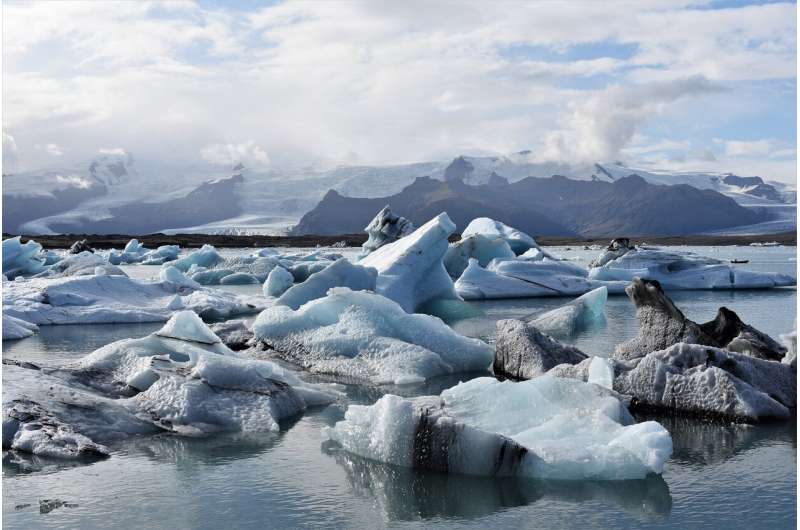Researchers discover a new tool for reconstructing ancient sea ice to study climate change

Sea ice is a critical indicator of changes in the Earth's climate. A new discovery by Brown University researchers could provide scientists a new way to reconstruct sea ice abundance and distribution information from the ancient past, which could aid in understanding human-induced climate change happening now.
In a study published in Nature Communications, the researchers show that an organic molecule often found in high-latitude ocean sediments, known as tetra-unsaturated alkenone (C37:4), is produced by one or more previously unknown species of ice-dwelling algae. As sea ice concentration ebbs and flows, so do the algae associated with it, as well as the molecules they leave behind.
"We've shown that this molecule is a strong proxy for sea ice concentration," said Karen Wang, a Ph.D. student at Brown and lead author of the research. "Looking at the concentration of this molecule in sediments of different ages could allow us to reconstruct sea ice concentration through time."
Other types of alkenone molecules have been used for years as proxies for sea surface temperature. At different temperatures, algae that live on the sea surface make differing amounts of alkenones known as C37:2 and C37:3. Scientists can use the ratios between those two molecules found in sea sediments to estimate past temperature. C37:4—the focus of this new study—had been long considered a bit of problem for temperature measurements. It turns up in sediments taken from closer to the Arctic, throwing off the C37:2/C37:3 ratios.
"That was mostly what the C37:4 alkenone was known for—throwing off the temperature ratios," said Yongsong Huang, principal investigator of the National Science Foundation-funded project and a professor in Brown's Department of Earth, Environmental and Planetary Science. "Nobody knew where it came from, or whether it was useful for anything. People had some theories, but no one knew for sure."
To figure it out, the researchers studied sediment and sea water samples containing C37:4 taken from icy spots around the Arctic. They used advanced DNA sequencing techniques to identify the organisms present in the samples. That work yielded previously unknown species of algae from the order Isochrysidales. The researchers then cultured those new species in the lab and showed that they were indeed the ones that produced an exceptionally high abundance of C37:4.
The next step was to see whether the molecules left behind by these ice-dwelling algae could be used as a reliable sea ice proxy. To do that, the researchers looked at concentrations of C37:4 in sediment cores from several spots in the Arctic Ocean near the present-day sea ice margins. In the recent past, sea ice in these spots is known to have been highly sensitive to regional temperature variation. That work found that the highest concentrations of C37:4 occurred when climate was coldest and ice was at its peak. The highest concentrations dated back to the Younger-Dryas, a period of very cold and icy conditions that occurred around 12,000 years ago. When climate was at its warmest and ice ebbed, C37:4 was sparse, the research found.
"The correlations we found with this new proxy were far stronger than other markers people use," said Huang, a research fellow at the Institute at Brown for Environment and Society. "No correlation will be perfect because modeling sea ice is a messy process, but this is probably about as strong as you're going to get."
And this new proxy has some additional advantages over others, the researchers say. One other method for reconstructing sea ice involves looking for fossil remains of another kind of algae called diatoms. But that method becomes less reliable further back in time because fossil molecules can degrade. Molecules like C37:4 tend to be more robustly preserved, making them potentially better for reconstructions over deep time than other methods.
The researchers plan to further research these new algae species to better understand how they become embedded in sea ice, and how they produce this alkenone compound. The algae appear to live in brine bubbles and channels inside sea ice, but it may also bloom just after the ice melts. Understanding those dynamics will help the researchers to better calibrate C37:4 as a sea ice proxy.
Ultimately, the researchers hope that the new proxy will enable better understanding of sea ice dynamics through time. That information would improve models of past climate, which would make for better predictions of future climate change.
More information: Karen Jiaxi Wang et al, Group 2i Isochrysidales produce characteristic alkenones reflecting sea ice distribution, Nature Communications (2021). DOI: 10.1038/s41467-020-20187-z
Journal information: Nature Communications
Provided by Brown University



















